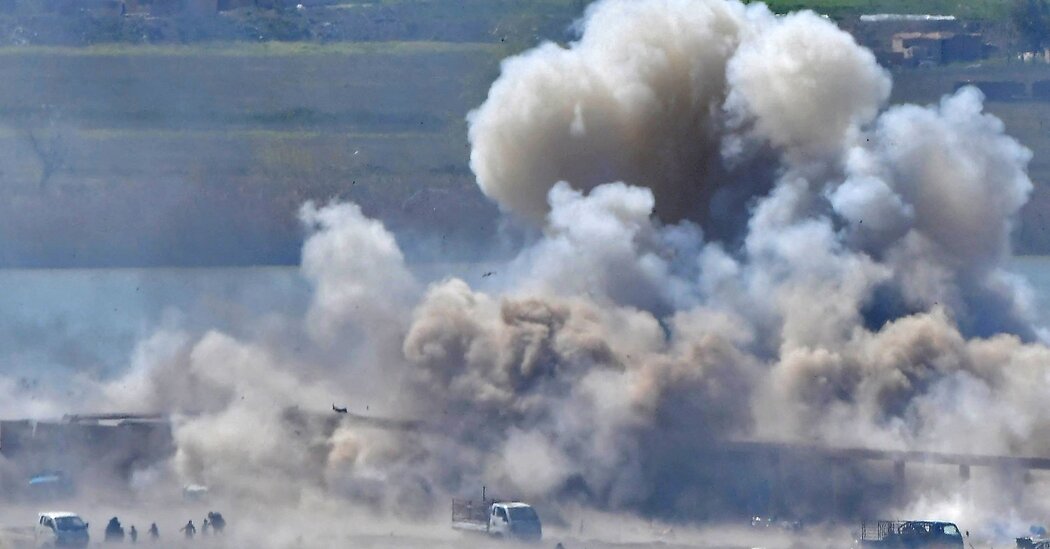
WASHINGTON — Defense Secretary Lloyd J. Austin III has ordered the military’s top commander in the Middle East to brief him on details of a U.S. airstrike in Syria in 2019 that killed dozens of women and children, the Pentagon said on Monday.
The Pentagon’s top spokesman, John F. Kirby, said Mr. Austin, who became secretary this year after the Biden administration took office, requested the briefing after reading an investigative report published over the weekend by The New York Times detailing the strike and allegations that top officers and civilian officials sought to conceal the casualties.
Gen. Kenneth F. McKenzie Jr., the head of the military’s Central Command, which oversaw the air war in Syria, will “brief him more specifically on that particular airstrike” and its handling, Mr. Kirby told reporters.
Mr. Kirby would not comment on details of the strike, a bombing at Baghuz, Syria, on March 18, 2019, that was part of the final battle against Islamic State fighters in the last shard of a once-sprawling religious state across Iraq and Syria. It was one of the largest civilian casualty incidents of the yearslong war against ISIS, but had never been publicly acknowledged by the U.S. military.
“I’m not going to relitigate a strike that happened back in March of 2019,” Mr. Kirby said.
Instead, he sought to defend the American military’s standards and procedures for waging a modern, precision-strike war that also emphasizes mitigation of the risk to civilians.
“No military in the world works as hard as we do to avoid civilian casualties,” Mr. Kirby said. “That doesn’t mean that we don’t always get it right. We don’t. We work hard to avoid civilian harm. We also want to take a look at ourselves.”
The Times investigation showed that the death toll from the strike was almost immediately apparent to military officials. A legal officer flagged the bombing as a possible war crime that required an investigation. But at nearly every step, the military made moves that concealed the catastrophic strike. The death toll was downplayed. Reports were delayed, sanitized and classified. U.S.-led coalition forces bulldozed the blast site. And top leaders were not notified.
An initial battle damage assessment quickly found that the number of dead was about 70.
The Times investigation found that the bombing by Air Force F-15 attack jets had been called in by a classified American Special Operations unit, Task Force 9, which was in charge of ground operations in Syria. The task force operated in such secrecy that at times it did not inform even its own military partners of its actions. In the case of the Baghuz bombing, the air command center at Al Udeid Air Base in Qatar had no idea the strike was coming, an officer who served at the command center said.
The Defense Department’s independent inspector general began an inquiry, but the report containing its findings was stalled and stripped of any mention of the strike.
Mr. Kirby said, though, that two studies examining civilian casualties commissioned by the Pentagon were wrapping up, and would soon be made public.
One study, by RAND Corporation and started during the Trump administration by the Pentagon’s Special Operations policy office, specifically looks at civilian casualties caused by military operations in Raqqa, Syria, the Islamic State’s former de facto capital. Mr. Kirby said he did not know if the March 2019 airstrike would be included in that review.
Key Findings From the Baghuz Airstrike Investigation
Uncovering the truth. Over several months, The New York Times pieced together the details of a 2019 airstrike in Baghuz, Syria, one of the largest civilian casualty incidents of the war against the Islamic State. Here are the key findings from the investigation:
A second study, also by RAND and required by Congress as part of a recent military policy bill, looks at the broader issue of civilian casualties in American military operations worldwide, Mr. Kirby said.
“We’re willing to keep looking at ourselves with respect to civilian harm, and to do everything we can to try to mitigate that,” he said.
Last week, after The Times sent its findings to U.S. Central Command, the command acknowledged the attack for the first time, saying that 80 people were killed but that the airstrike was justified. It said three bombs — one 500-pound and two 2,000-pound munitions — killed 16 fighters and four civilians. As for the other 60 people killed, the statement said it was not clear that they were civilians, in part because women and children in the Islamic State sometimes took up arms.
Human rights advocates expressed outrage on Monday at the strike and the military’s handling of it, and demanded that Congress open an independent investigation.
“Clearly, the U.S. military isn’t going to fix it,” said Sarah Holewinski, the Washington director of Human Rights Watch and a former senior adviser on human rights to the military’s Joint Staff. “The Pentagon has never prioritized civilian harm. Ever. I’m tired of that talking point.”


More Stories
The New GOP Majority’s First Move Could Be To Gut A Key Ethics Watchdog
Ryan Zinke Returns To Congress, Promptly Misattributes Quote To His Hero
Congress Just Gained A Rare New Member: Someone Who Worked As A Public Defender